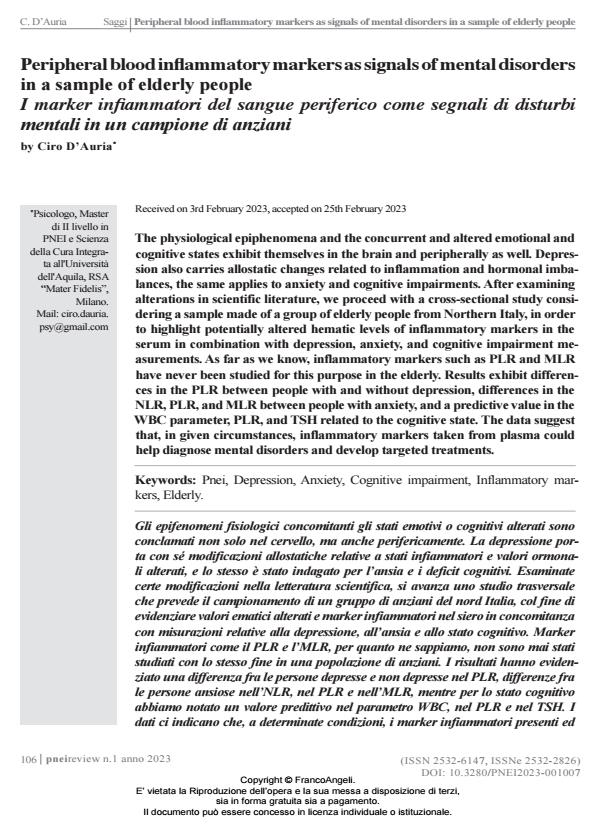Peripheral blood infl ammatory markers as signals of mental disorders in a sample of elderly people
Titolo Rivista PNEI REVIEW
Autori/Curatori Ciro D’Auria
Anno di pubblicazione 2023 Fascicolo 2023/1
Lingua Inglese Numero pagine 17 P. 106-122 Dimensione file 1122 KB
DOI 10.3280/PNEI2023-001007
Il DOI è il codice a barre della proprietà intellettuale: per saperne di più
clicca qui
Qui sotto puoi vedere in anteprima la prima pagina di questo articolo.
Se questo articolo ti interessa, lo puoi acquistare (e scaricare in formato pdf) seguendo le facili indicazioni per acquistare il download credit. Acquista Download Credits per scaricare questo Articolo in formato PDF

FrancoAngeli è membro della Publishers International Linking Association, Inc (PILA)associazione indipendente e non profit per facilitare (attraverso i servizi tecnologici implementati da CrossRef.org) l’accesso degli studiosi ai contenuti digitali nelle pubblicazioni professionali e scientifiche
The physiological epiphenomena and the concurrent and altered emotional and cognitive states exhibit themselves in the brain and peripherally as well. Depres- sion also carries allostatic changes related to inflammation and hormonal imba- lances, the same applies to anxiety and cognitive impairments. After examining alterations in scientific literature, we proceed with a cross-sectional study consi- dering a sample made of a group of elderly people from Northern Italy, in order to highlight potentially altered hematic levels of inflammatory markers in the serum in combination with depression, anxiety, and cognitive impairment me- asurements. As far as we know, inflammatory markers such as PLR and MLR have never been studied for this purpose in the elderly. Results exhibit differen- ces in the PLR between people with and without depression, differences in the NLR, PLR, and MLR between people with anxiety, and a predictive value in the WBC parameter, PLR, and TSH related to the cognitive state. The data suggest that, in given circumstances, inflammatory markers taken from plasma could help diagnose mental disorders and develop targeted treatments.
Gli epifenomeni fisiologici concomitanti gli stati emotivi o cognitivi alterati sono conclamati non solo nel cervello, ma anche perifericamente. La depressione por- ta con sé modificazioni allostatiche relative a stati infiammatori e valori ormona- li alterati, e lo stesso è stato indagato per l’ansia e i deficit cognitivi. Esaminate certe modificazioni nella letteratura scientifica, si avanza uno studio trasversale che prevede il campionamento di un gruppo di anziani del nord Italia, col fine di evidenziare valori ematici alterati e marker infiammatori nel siero in concomitanza con misurazioni relative alla depressione, all’ansia e allo stato cognitivo. Marker infiammatori come il PLR e l’MLR, per quanto ne sappiamo, non sono mai stati studiati con lo stesso fine in una popolazione di anziani. I risultati hanno eviden- ziato una differenza fra le persone depresse e non depresse nel PLR, differenze fra le persone ansiose nell’NLR, nel PLR e nell’MLR, mentre per lo stato cognitivo abbiamo notato un valore predittivo nel parametro WBC, nel PLR e nel TSH. I dati ci indicano che, a determinate condizioni, i marker infiammatori presenti ed evidenziati nel plasma potrebbero contribuire alla diagnosi e all’elaborazione di trattamenti più mirati per i disturbi mentali.
Parole chiave:Pnei, Depressione, Ansia, Compromissione cognitiva, Marker infiam- matori, Anziani.
Ciro D’Auria, Peripheral blood infl ammatory markers as signals of mental disorders in a sample of elderly people in "PNEI REVIEW" 1/2023, pp 106-122, DOI: 10.3280/PNEI2023-001007